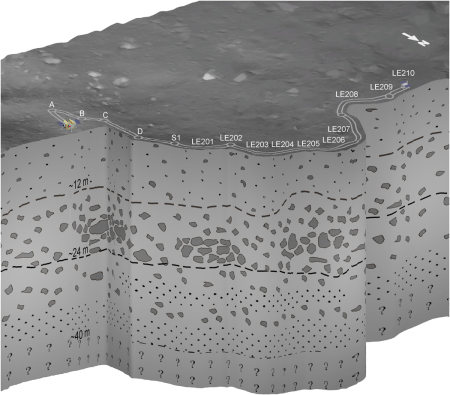Chinese scientists publish radar results from Chang’e-4 lander

The new colonial movement: Chinese scientists today published their first ground-penetrating radar results from their Chang’e-4 lander on the far side of the Moon.
Using a ground-penetrating radar instrument on Chang’e-4, researchers have found that the rover is likely sitting on different layers of ejecta—debris from multiple impacts over time that rained down at high velocities to blanket the lunar surface and now fill the crater. “[We] see a very clear sequence of [layers],” says Elena Pettinelli of Roma Tre University in Italy, one of the paper’s co-authors.
The rover’s radar instrument was able to penetrate up to 40 meters below the surface of the moon, more than twice the distance achieved by its predecessor, the Chang’e-3 mission, which landed on the lunar near side in December 2013. Data from the latest mission show three distinct layers beneath the rover: one made of lunar regolith, or soil, down to 12 meters; another made of a mix of smaller and larger rocks down to 24 meters; and a third with both coarse and fine materials extending the rest of the 40-meter depth.
The figure to the right comes from the paper [pdf] Though the layers have not been dated, their differences suggest different past events in the formation of this surface.
These results are excellent, but they also have many uncertainties. Radar can tell you a lot, but the only way you can really ever know anything about what’s below ground is to go there and actually do some digging.
On Christmas Eve 1968 three Americans became the first humans to visit another world. What they did to celebrate was unexpected and profound, and will be remembered throughout all human history. Genesis: the Story of Apollo 8, Robert Zimmerman's classic history of humanity's first journey to another world, tells that story, and it is now available as both an ebook and an audiobook, both with a foreword by Valerie Anders and a new introduction by Robert Zimmerman.
The print edition can be purchased at Amazon or from any other book seller. If you want an autographed copy the price is $60 for the hardback and $45 for the paperback, plus $8 shipping for each. Go here for purchasing details. The ebook is available everywhere for $5.99 (before discount) at amazon, or direct from my ebook publisher, ebookit. If you buy it from ebookit you don't support the big tech companies and the author gets a bigger cut much sooner.
The audiobook is also available at all these vendors, and is also free with a 30-day trial membership to Audible.
"Not simply about one mission, [Genesis] is also the history of America's quest for the moon... Zimmerman has done a masterful job of tying disparate events together into a solid account of one of America's greatest human triumphs."--San Antonio Express-News

The new colonial movement: Chinese scientists today published their first ground-penetrating radar results from their Chang’e-4 lander on the far side of the Moon.
Using a ground-penetrating radar instrument on Chang’e-4, researchers have found that the rover is likely sitting on different layers of ejecta—debris from multiple impacts over time that rained down at high velocities to blanket the lunar surface and now fill the crater. “[We] see a very clear sequence of [layers],” says Elena Pettinelli of Roma Tre University in Italy, one of the paper’s co-authors.
The rover’s radar instrument was able to penetrate up to 40 meters below the surface of the moon, more than twice the distance achieved by its predecessor, the Chang’e-3 mission, which landed on the lunar near side in December 2013. Data from the latest mission show three distinct layers beneath the rover: one made of lunar regolith, or soil, down to 12 meters; another made of a mix of smaller and larger rocks down to 24 meters; and a third with both coarse and fine materials extending the rest of the 40-meter depth.
The figure to the right comes from the paper [pdf] Though the layers have not been dated, their differences suggest different past events in the formation of this surface.
These results are excellent, but they also have many uncertainties. Radar can tell you a lot, but the only way you can really ever know anything about what’s below ground is to go there and actually do some digging.
On Christmas Eve 1968 three Americans became the first humans to visit another world. What they did to celebrate was unexpected and profound, and will be remembered throughout all human history. Genesis: the Story of Apollo 8, Robert Zimmerman's classic history of humanity's first journey to another world, tells that story, and it is now available as both an ebook and an audiobook, both with a foreword by Valerie Anders and a new introduction by Robert Zimmerman.
The print edition can be purchased at Amazon or from any other book seller. If you want an autographed copy the price is $60 for the hardback and $45 for the paperback, plus $8 shipping for each. Go here for purchasing details. The ebook is available everywhere for $5.99 (before discount) at amazon, or direct from my ebook publisher, ebookit. If you buy it from ebookit you don't support the big tech companies and the author gets a bigger cut much sooner.
The audiobook is also available at all these vendors, and is also free with a 30-day trial membership to Audible.
"Not simply about one mission, [Genesis] is also the history of America's quest for the moon... Zimmerman has done a masterful job of tying disparate events together into a solid account of one of America's greatest human triumphs."--San Antonio Express-News


I can’t wait to see what the images would show when such a radar is used in a polar area especially a permanently-shadowed crater. The Chang’e 4 radar results are entirely unsurprising.